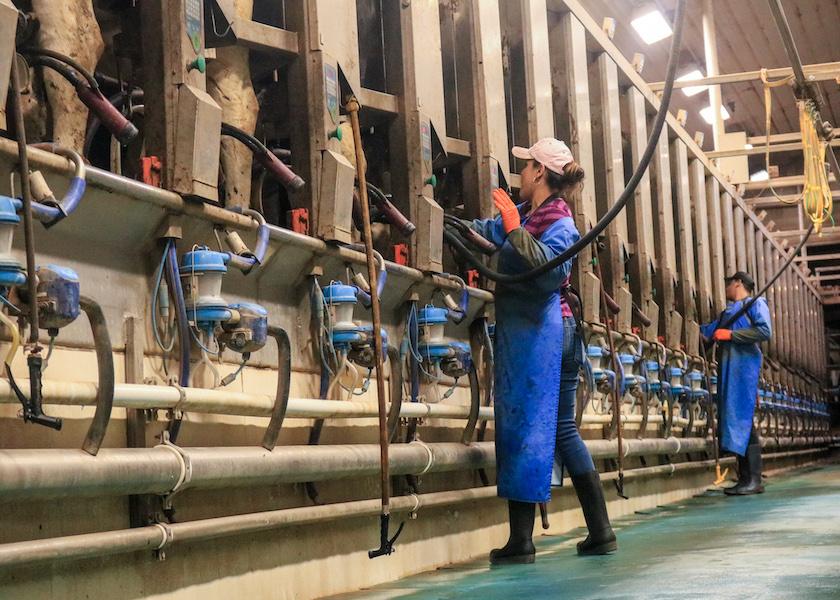5 Practices to help Dairy Producers reduce Somatic Cell Counts

Somatic cell count (SCC), one of the top indicators of milk quality, can be defined as the total number of cells per milliliter in milk. Primarily, SCC is composed of leukocytes, or white blood cells, that are produced by the cow’s immune system to fight an inflammation in the mammary gland.
Because SCC is a good indicator of milk quality, a lower SCC score hints at the reduced likeliness the milk is to contain harmful bacteria. A general rule of thumb is to aim for a herd score of 200,000 cells/mL or less. A higher SCC score can have negative effects on milk quality, shelf life and manufacturing yield.
During the 2020 National Mastitis Council Annual Meeting, Peter Edmondson, a British dairy veterinarian specializing in mastitis and milk quality, and owner of UdderWise Ltd., touched on five steps to reduce a high SCC score.
1. Identify high-SCC cows.
To help identify individual cows with high SCC scores, run milk quality tests monthly to help monitor herd trends and pinpoint infected cows.
Running monthly bulk tank cultures through a reliable laboratory is also a good way to find out what kinds of bacteria are causing mammary infections.
2. Reduce the spread of infection.
In order to lower an elevated SCC score, help producers prioritize proper milking procedures to help reduce the spread of infection. Edmondson provided these steps as a starting point:
o Create a high SCC cow group within the herd. These animals should be milked last to help prevent mastitis causing bacteria from spreading to healthy, low-SCC cows.
o Keeping gloves clean is another useful tactic to prevent bacteriological contamination. Even clean hands can be loaded with mastitis spreading organisms. Thus, it is imperative to wear gloves at all times when milking and to replace/sterilize dirty gloves as necessary.
o Use one towel per cow when wiping and drying teat ends. When using cloth towels, wash and dry them at a high temperature, Edmondson says. After 500 to 600 milkings, discard cloth towels and replace with new ones.
o Proper pre-milking and post-milking procedures can also keep high SCC scores at bay. Post-dipping reduces new infection rates by approximately 50%, Edmondson notes. However, it does not kill all of the bacteria, so proper equipment sanitation is a must.
o Determine when to change milking machine liners. “A liner can spread Staphylococcus aureus to the next six to eight cows after milking an infected cow,” he warns. Traces of milk can remain in the liner and bacteria are more likely to spread when liners are worn.
o Keep farm staff well-trained on milk quality indicators and standard operating milking procedures. Explain why a good SCC is important and praise good mastitis control. “A simple whiteboard with basic mastitis data can be an invaluable [tool],” Edmondson says.
3. Know which organism you need to treat.
In order to obtain a lower SCC, it is important to know what you are up against. Certain types of bacteria are responsible for subclinical mastitis, and it is necessary to know which organism you need to treat.
“Bacteriology testing is essential when making decisions about problem cows,” Edmondson says. He recommends collecting milk samples from high SCC cows who represent different ages along with chronic vs. recent mastitis infections.
4. Develop a road map.
Once you have determined the type of bacteria you need to treat for, it is time to start making decisions.
Edmondson notes that it is influential to focus on cows who are contributing the highest percentage of somatic cells to the bulk tank.
To determine which animals those are, consider their individual SCC history, age, response to previous antibiotic dry-cow therapy, clinical mastitis history, milk production, fertility status, locomotion or lameness problems, along with the animal’s overall health. From there, you can decide whether to treat, dry up or cull.
“Culling is expensive and irreversible; it’s important to get these decisions right,” Edmondson says.
5. Monitor progress.
Having a low SCC never happens by accident. It is the result of high intention, sincere effort, intelligent direction and skillful execution. In order to obtain a lower score, it is crucial to know a herd’s current SCC average in order to track progress.
According to Edmondson, it takes about one year before you typically begin to see significant herd SCC reduction. Therefore, it is necessary to have measurable goals so you can track progress and help producers and their employees stay motivated to reduce SCC levels.







